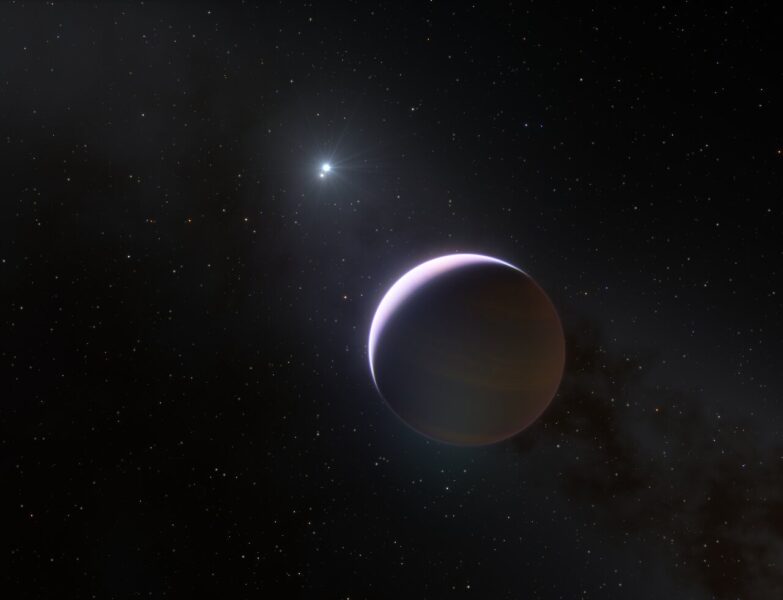10.12.2021

This image shows the massive binary system known as b Centauri and its giant planet, b Centauri (AB)b. This is the first time astronomers have directly observed a planet orbiting a star pair this massive. The duo, which have a total mass of at least six Suns, is the bright object in the top left corner of the image. The bright and dark rings around it are imaging artifacts. The planet, visible as a bright dot in the lower right of the frame, is a super-Jupiter that orbits the pair at 560 a.u. The other bright dot in the image (top right) is a background star.
ESO / Janson et al.
Astronomers have imaged a giant planet around a massive pair of stars known as b Centauri. While Jupiter’s orbit around the Sun is five times wider than Earth’s, this planet is 100 times farther out, circling its star at 560 times the average Earth-Sun distance.
The discovery, published in the December 9th Nature, challenges our notions of how planets form.
Markus Janson (Stockholm University, Sweden) and colleagues discovered the planet in observations taken in 2019 as part of the B-star Exoplanet Abundance Study (BEAST), using the SPHERE instrument on the European Southern Observatory’s Very Large Telescope in Chile. Follow up in 2021 confirmed the planet’s existence. The real kicker, though, was an observation taken two decades earlier as part of a different project. The planet was visible back then but discarded for being too faint. Including the earlier observation enabled the researchers to trace the object’s orbit and confirm that not only is it moving with the b Centauri system, it’s actually orbiting the central stars.
The planet’s mass, which comes from measurements of the glow leftover from its formation, isn’t pinned down exactly. Given uncertainties in the evolution of young giant planets, it’s probably between 9.3 and 12.5 Jupiters, near the edge of the dividing line between planets and the failed stars known as brown dwarfs.
The planet, dubbed b Centauri (AB)b to denote that it circles both massive stars, stands out both for its mass and its orbit, which is one of the widest known — equivalent to that of Sedna in the outer solar system. But the planet is a million times more massive than the Kuiper Belt object, which puts planet formation scenarios to the test.
HOW TO FORM A GIANT, FAR OUT PLANET
Astronomers think most planets form via core accretion. Early on, when a protoplanetary disk of dust and gas still surrounds the star, dust grains stick together, collide, and merge their way up to planet sizes. The heft of those forming beyond the system’s snow lines, where gases turn to ices, attracts a gaseous outer layer.
But if planets form too far out, there won’t be any gas for them to attract. This is especially true around massive stars, whose intense radiation dissipates gas more quickly than around smaller stars. Though perhaps there’s a loophole, since those disks dissipate from the inside out, giving planets on the widest orbits more time to grow.
It’s possible that the planet did form via core accretion but closer in, before a gravitational encounter flung it outward. But the planet’s relatively circular orbit (in astronomical terms, its eccentricity is less than 0.4) makes this scenario less likely.

ESO / L. Calçada
A third option is gravitational instability. In this option, a build-up of material in a particular area of the disk, even far out from the star, can collapse into a solid body. The catch is that, at least in our understanding of the process, gravitational instability ought to create more massive objects, such as brown dwarfs and even stars.
The key is not so much the object’s mass itself but its mass relative to its host. And in the b Centauri system, the planet is at least a tenth of the stars’ combined mass — the planet would tilt the scales relative to its stars in the much same way that Jupiter tilts the scales relative to the Sun. So gravitational instability, too, has its issues, though it’s still the scenario the researchers favor.
Whatever way far-out giants form around massive stars, the process seems to be common across the class. Previous studies of massive stars (albeit, less massive than the ones considered here) have shown a trend for bigger stars to host bigger planets in wider orbits.
“The authors have discovered a wonderful new planet, although from this paper alone, we can't draw any general conclusions about planet formation and its dependence on mass because it's only a single detection,” cautions Joshua Winn (Princeton), who wasn’t involved in the study. Firmer conclusions require larger samples of planets around massive stars.
The discovery highlights the variety of worlds the last few decades have brought us. Even considering only Jovian planets, we now know of “hot Jupiters” that whirl around their star in mere hours while b Cen (AB)b takes thousands of years to complete an orbit. “If a child had been asked to draw a planet 30 years ago, they would have had a relatively straightforward task,” Kratter writes. “Now, the options are dizzying.”
NOT TO BE CONFUSED WITH . . .
Note that b Centauri is not to be confused with Beta Centauri, the second-brightest star in the constellation. (They’re similarly far away, though: The b Centauri pair is 325 light-years from Earth; Beta Centauri is at almost 400 light-years.) Beta Centauri has no known exoplanets.
Nor is b Centauri to be confused with the Alpha Centauri system just 4 light-years away, in which we’ve discovered two bona fide planets (Proxima Centauri b and c) as well as two candidate (Alpha Centauri Ab and Alpha Centauri Bc) that require further observations to confirm. The TOLIMAN mission concept aims to continue the search for planets in the system.
Quelle: Sky&Telescope
